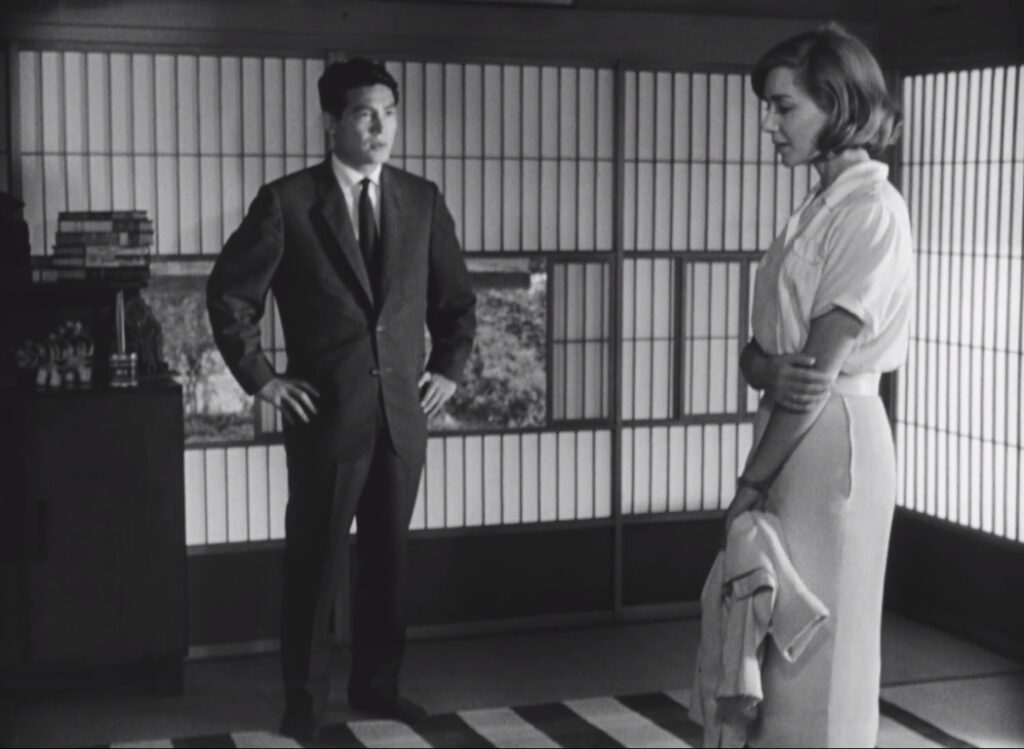
Hiroshima mon amour
1959, directed by Alain Resnais
In the last ten minutes of Hiroshima mon amour, shortly before daybreak, the two lovers enter a nightclub called “Casablanca”. In her white outfit, neck-length blonde hair, and pensive expression, Emmanuele Riva’s character in this scene looks remarkably like Ilsa Lund, Ingrid Bergman’s character in the classic 1942 movie. Given the two lovers on the verge of parting forever, the allusion is easy enough to spot, but its purpose may not be as clear.
Casablanca and Hiroshima mon amour bracket opposite ends of World War II: one is set during the same month as Pearl Harbor and anticipates the sacrifices ahead; the other looks back across fourteen years at the bombing of Hiroshima and the liberation of France. Paris plays a role in both films, but in this too they are opposite – in one, Paris is a memory that will sustain its characters for life (“We’ll always have Paris”); in the other Paris represents the obliteration of memory. On the exact day of the Hiroshima atom bomb Riva’s character fled to Paris to escape her hometown of Nevers, where she had been shamed for her wartime affair with a German soldier. She tells her Japanese lover, Eiji Okada’s character, that she has ceased thinking of Nevers and never wishes to return.
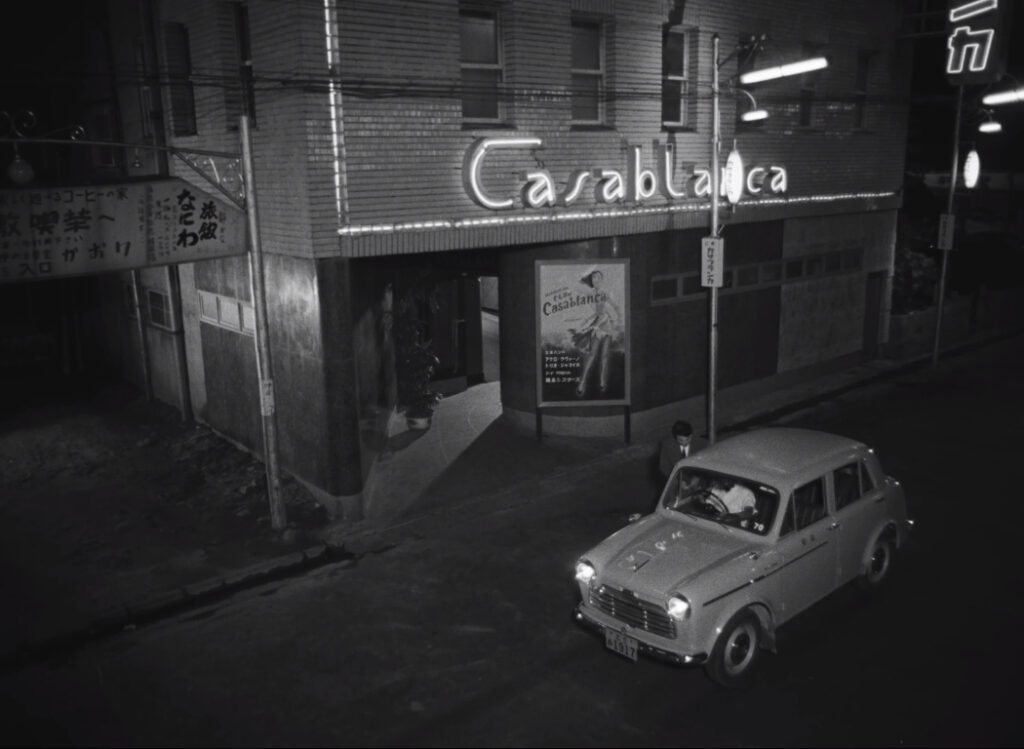
It’s hard for an English-speaking viewer to ignore the likeness between “Nevers” and “never”. As a rule it’s not usually wise to draw conclusions about a movie script from coincidences in translation, but can we really believe that Marguerite Duras, who wrote Hiroshima mon amour and whose films are always full of rhymes and echoes, didn’t choose the town of Nevers for this exact reason? Again and again the town’s name appears alongside the French “jamais” (“never”):
- “I’m never going back to Nevers.” “Never?” “Never. I was never younger than I was in Nevers.”
- “I somehow understand that it was there [Nevers] that I almost lost you and ran the risk of never, ever meeting you.”
- “You think you know, but no. Never. In her youth in Nevers she had a German love. ‘We’ll go to Bavaria, my love, and we’ll get married.’ She never went to Bavaria. Let those who never went to Bavaria dare speak to her of love!”
Almost precisely halfway through the film, in the first line in the long tea house scene, Okada’s character asks the pregnant question, “Does Nevers have any other meaning in French?” Riva answers that it does not, and the subject is dropped. Why raise the question, except to call attention to the obvious meaning of “never” in the dominant world language? Here, then, we have yet another opposition to Casablanca, “never” being opposite to the “always” in “We’ll always have Paris.”
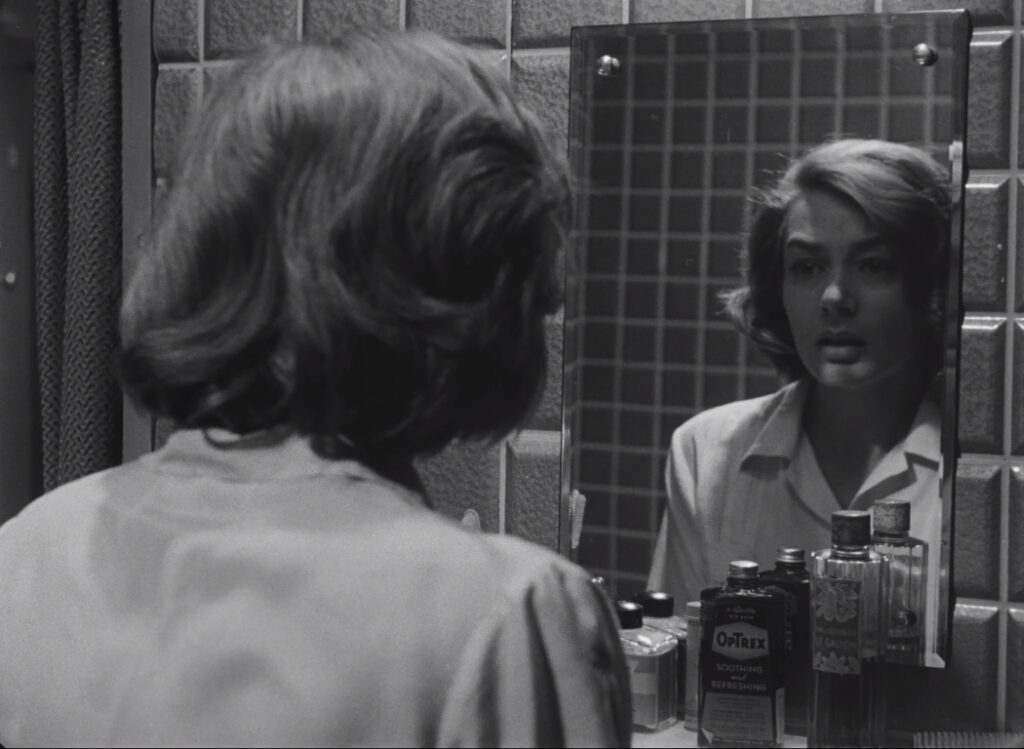
But how opposite, really, are the two movies to each other? Both, clearly enough, are about the experience of time. Most people seem to gather that Hiroshima mon amour is about the pain of forgetting, but if we understand forgetting to mean the willful obliteration of memory, rather than the natural erosion of memory with time, then the movie crosses into more fertile territory. Riva’s character has banished Nevers from her mind because she rejects her experience of shame and punishment after the liberation. Instead of “We’ll always have Paris” she’ll “never have Nevers”. But in Casablanca, Rick too had obliterated his once cherished memory, spending a year and a half in bitter self-absorption. During Ilsa’s brief return to his life, they are both able to recapture Paris and restore it to a position of happiness. Hiroshima mon amour traces a similar arc. In the train station right before the Casablanca nightclub, she finally contemplates returning to Nevers, picturing the city’s beauty and looking back on it fondly. In the movie’s last seconds, the two unnamed lovers assign each other their names – she calls him “Hiroshima” and he names her “Nevers”. Both are now identified with the sites of their traumas. It’s the same kind of reconciliation that Giuliana will go through at the end of Red Desert when she comes to understand that everything that happens to her, no matter how unwelcome, belongs to the substance of her life. Characters who reject their experience, who deny that it belongs to them, whether Rick or Giuliana or the woman from Nevers, inevitably run into trouble. In the end, Hiroshima mon amour is more akin to Casablanca than opposite to it.
The movie, however, is more than a prescription to embrace experience. As much as any regular narrative movie, it explores its protagonist’s evolution. She comes to reconcile with her unbearable past, visiting a city whose past is also unbearable and trying to understand other people’s trauma. She visits the war museum, watches newsreels, and learns about the suffering caused by the atom bomb. The first scene is intercut with images of Hiroshima’s pain and devastation, but her lover reminds her, insistently, that she cannot know the experience of the bomb’s victims. The memory belongs to them alone; it cannot be had cheaply through documentaries, photos, museum exhibits, or books. Nevertheless, by approaching other people’s pain as something worth trying to understand, she readies herself to confront and assimilate her own unwanted memory.
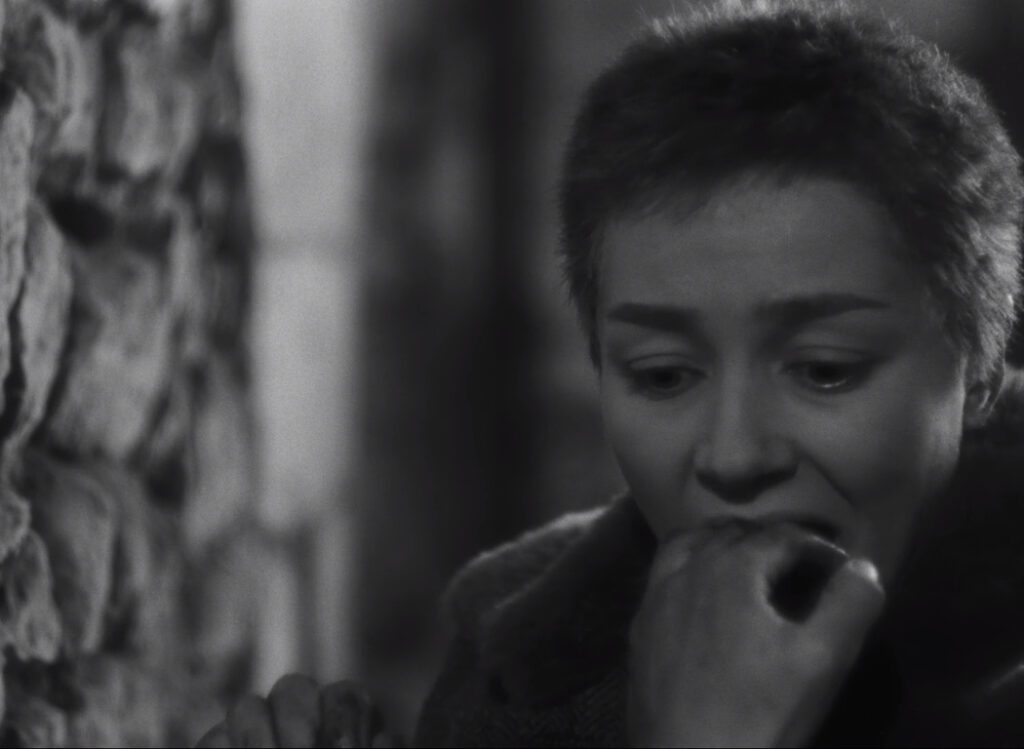
In the opening scene her lover asks, “Why did you want to see everything in Hiroshima?” She answers, “It interested me. I have my own idea about it. For example, looking closely at things is something that has to be learned.” This idea of seeing clearly by looking with intensity recurs throughout Marguerite Duras’ films, and Antonioni’s films as well, with the caveat that we must look at life as it comes to us rather than choosing to look at the dramatic and glamorous. Although she cannot possibly see the horrors of Hiroshima with due clarity, nevertheless she can look at her own past. Her earliest moment of intense vision occurs precisely one hour into the film, in one of the Nevers flashbacks, when after being re-consigned to the basement, a little toy ball falls from the street above. She examines the ball with an unexpected depth of interest. It’s a simple object, fitting for an exercise in “looking closely at things,” but the sphere also represents the world itself, which she must learn to look at with all her powers of vision. She tells us that at this moment her obsessive hatred, which she had described so emphatically earlier, finally vanished.
The act of seeing will be the key to her reconciliation as she re-opens her memory of Nevers and confesses her worst humiliations. Her Japanese lover becomes a willing proxy for her deceased German lover (a fair exchange, as she had indulged him in regarding her as “a thousand women in one”). In the final scene, in the hotel just before her scheduled flight, she starts to panic: “I’ll forget you! I’m forgetting you already!” She doesn’t want her happiness in Japan to be shrouded by unhappiness like her wartime affair was. Then she cries, “Look how I’m forgetting you! Look at me!” Again the verb “look” – but as soon as she says it, she knows that the price between lovers is reciprocation. She looks at him like she’s never looked at him before, and at once she realizes that he, like herself, is inseparable from his own terrible experience, summed up by the name of Hiroshima where he lost his entire family. She calls him by that name: “Hi-ro-shi-ma. Hiroshima. That’s your name.” And when she does this, at last she is ready to hear him do the same. She is Nevers – the experience she wanted to erase has made her who she is, and she is not diminished by it.
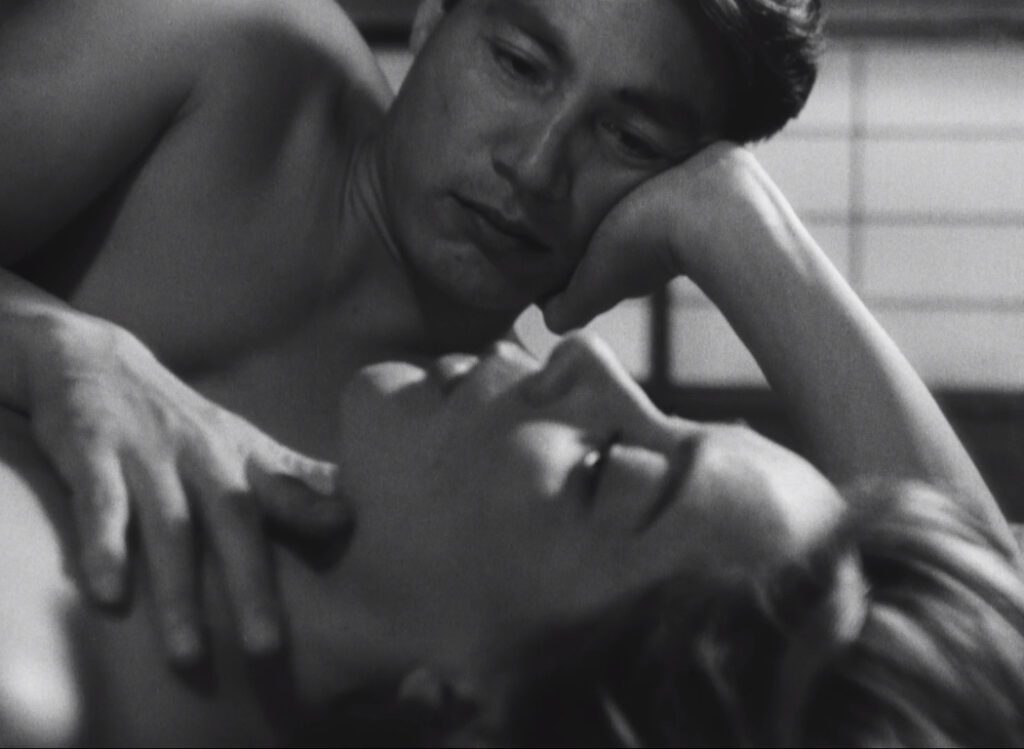
This lesson could have been filmed any number of ways, certainly without having to leave France. Everywhere in the world people try to live as if their horrible experiences never happened. What distinguishes this movie – the elephant in the room that we haven’t yet faced – is its reference to the atom bomb. For the same reasons that Okada’s character denies that his lover has seen anything of Hiroshima, we should be skeptical of any film that tries to import the horror of that event. There is no way to render it as cinema. Even a photographic representation of the mushroom cloud is a kind of sin, making a spectacle of something whose reality is in no significant degree a visual phenomenon. Reducing the event to a picture is irresponsible at best, because it promotes the power of the bomb while neglecting, and even disrespecting, its impact – which itself cannot be rendered fairly. Hiroshima mon amour by and large avoids this fault, only including a passing shot of the mushroom cloud’s outline etched on a museum exhibit. But it’s not enough that it avoids sensationalizing the bomb; how does it justify hanging the story on something so easily sensationalized?
When Emmanuele Riva tells her lover she’s in Hiroshima to make a film about peace, it’s hard not to guess that there might be a self-referential kernel of truth in the actress’s line. We see what kind of film her character is acting in, with anti-nuclear protest marches and Red Cross nurses ministering to a devastated city. Obviously Hiroshima mon amour is not that kind of conventional peace film, but what does it have to do with peace at all, if it’s about the need to look intensely at one’s own undesired experiences?
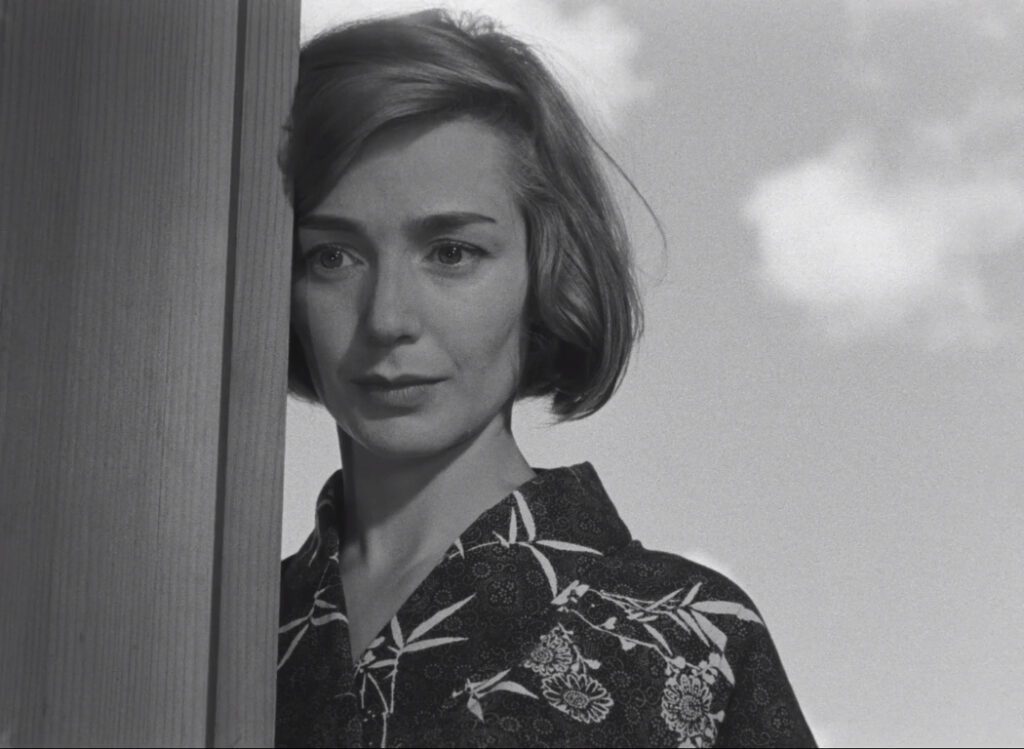
The answer comes almost half an hour into the movie, right after the two lovers leave the hotel. Speaking about her time after the war in Nevers she says, “That was my madness. I was mad with hate. I felt I could make a career of hating. All I cared about was hating.” We mustn’t get the idea that Hiroshima mon amour is just a nice lesson in happiness, or a platitude about “facing your hard times”. This speech about hate, combined with the pervasive allusion to the atom bomb, raises the stakes. The movie is about no less than the root of hatred. The story of this anonymous woman from Nevers is repeated billions of times, across all of humanity and all of its history. If only humans could learn to look honestly at their own private experiences, even those they’d rather forget, there would be no cause for hatred and no impetus for wars that risk the survival of our world.
CONNECTIONS:
Casablanca – Name of nightclub; resemblance to Bergman; beginning/end of WWII; always/never; about the way we hold onto time
Juliette, or the Key of Dreams – Willful obliteration of memory, rejection of experience
5 Fingers – Inversion of Casablanca, viewing the war from years later
Equinox Flower – Idea that embracing the past is a precondition for a good life in the present, expressed with reference to WWII; symbolic allusions to Hiroshima
La notte – Unheralded daybreak seen through a skylight or window near the end
Red Desert – Reconciliation and identification with an unhappy experience